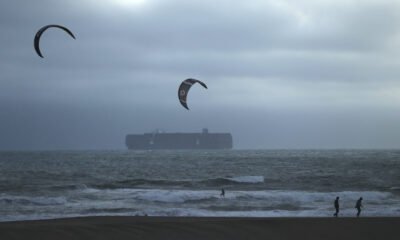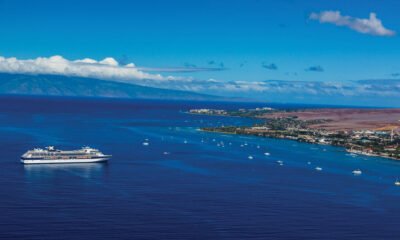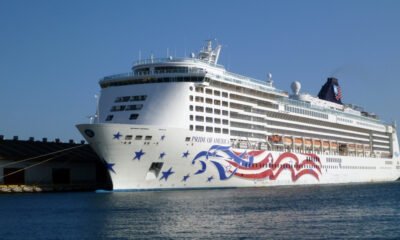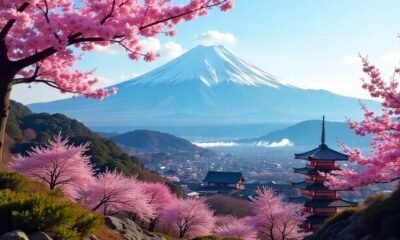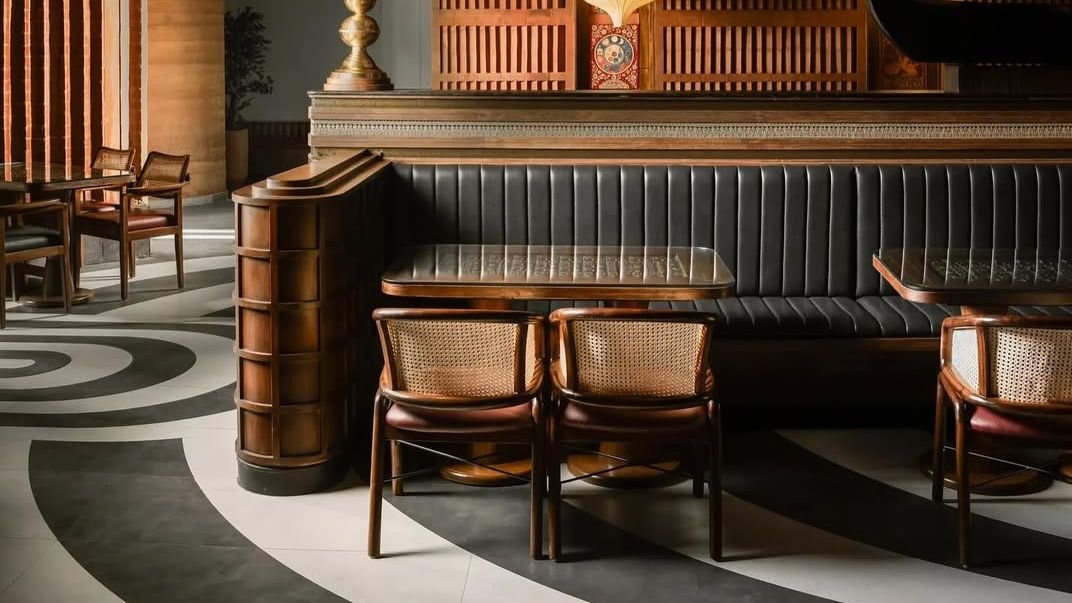Restaurants & Food
Pro Surfer John John Florence’s Guide to Oahu
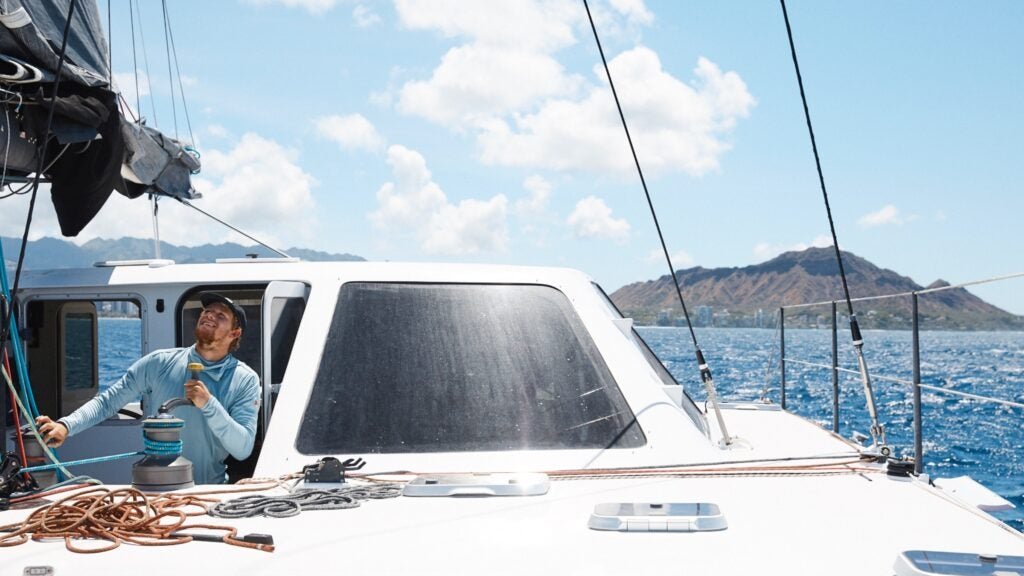
Diamond Head and Pearl Harbor are must-see attractions for most visitors to Oahu. Iolani Palace and sunset luaus are also popular. But John John Florence has other ideas of how to spend your time on Hawaii’s most touristed island.
The 30-year-old North Shore native, two-time world surfing champion, and member of the inaugural U.S. Olympic surf team was born and raised here. When he’s not dropping into a set wave or sailing, he enjoys meditative land-based pursuits: gardening, beekeeping, and mountain biking are three favorites.
Florence doesn’t often spend time in town, as locals call Honolulu, but he does have a set of places he frequents that don’t necessarily make it into his Instagram posts. (You have to keep some secrets from 1.5 million followers.) From the nicest beaches to the healthiest cafés to surfing, sailing, and hiking, here are his suggestions on the best ways to round out a trip to Oahu.
OUTSIDE: Oahu welcomed more than three million visitors in 2021. That’s a lot of people! Where would you send friends who want to see stunning beaches as well as get a sense of the wild side of the island but avoid the crowds?
FLORENCE: Oahu as a whole is a really beautiful place, and I enjoy every side of the island, but I’ll share a few stops from some different areas. Starting with the North Shore, pretty much anywhere you decide to pull over the car is going to be a really nice beach. Waimea Bay is a special place and perfect for a beach day. On the south shore, I like spending time in the Ala Moana area of Honolulu—the waves are fun, there are plenty of great restaurants, and the sailing scene and Friday-night races are rad. Lastly, I’d recommend checking out some of the nature reserves: the bird sanctuary at Kaena Point [the island’s westernmost tip], Sharks Cove on the North Shore, and Hanauma Bay [in the southeast], to name a few.
What are your recommendations for visiting the North Shore: What’s the best month, and where do you go if you’re up there to see pro surfers on big waves? And do you have any tips for amateurs surfing that stretch of coast?
I might be biased, but I think visiting the North Shore is fun any time of the year. Summer and winter have different faces, but both offer great things. I could give a big list, but instead I’ll shoot you an ideal day: During a contest day, head down to Pipeline and watch a few heats. It’s a fun environment and really cool seeing waves that big up close. Head over to Pupukea Grill for some food before heading into Haleiwa town to check out the local shops. If you’re looking to learn to surf, head over to Uncle Bryan’s surf school at Puaena Point for an afternoon lesson and sunset. That’s a pretty good day on the North Shore.
After surfing and sailing, what are your favorite outdoor activities on the island?
Recently I’ve gotten into biking, both road biking and mountain biking. They’ve been a lot of fun to learn about and use as another method of training. Also, I’m part of a solid crew of people who go downwind foiling. Foil boards are essentially surfboards on top of a large foil. We move with the wind—downwind—and basically see how far we can go without dropping back into the water. It’s a lot like snowboarding in powder, but in the ocean. I do that a lot.
If you only had time for one hike on Oahu, what should it be and why?
That’s a tough one, but I’d say Koko Head. It’s fairly well-known but not too long and offers great views on the southeastern side of the island.
I know you grow a lot of produce yourself, but when you’re out and about, where do you go to eat healthy, and what kind of local farmers’ markets or local farms would you encourage folks to seek out while they’re visiting?
There are definitely great farmers’ markets around the island. I also use an awesome resource called Farm Link; it groups together offerings from all the organic farms into one marketplace for purchase. They’re great. Kokua Hawaii Foundation’s Learning Farm—Kim and Jack Johnson’s nonprofit—is a fairly new farm and retail space in Haleiwa. It’s a really cool place to visit, learn about farming, and volunteer. As for healthy cafés, I like the Country Eatery and Raised by the Waves, both in Kahuku.
What do you do on a rainy day in Oahu?
I guess it depends how rainy it is. If it’s a flooding type of rain, there isn’t much you can do but we get a lot of light rain, too. That usually doesn’t stop my normal activities—surfing, mountain biking, or foiling. I suggest doing the same things you’d do on a sunny day. Rain passes quick!
Most mainlanders know that Hawaii is famous for poke and shave ice. Where do you go to get these? What other places with traditional food do you frequent, and do you have any favorite orders there?
Ha, we are kind of famous for those. I don’t have a shave ice place, but if I’m getting poke, I’ll stop by Kahuku Superette. The best, though, is when a friend catches fish and makes fresh poke at a BBQ or something. Some other food places I really like are Kahuku Farms and, in Haleiwa, Haleiwa Joe’s, Haleiwa Bowls for acai, and Pupukea Grill—everything at the grill is amazing!
As a sailor, do you have any recommendations for seeing the island that way, either with a company or with your own boat? Any off-the-radar coves or areas with notably more sea life or a fantastic swim or snorkel?
Yeah, definitely. There are a ton of great tours you can take. On the North Shore, Island View Hawaii has a really cool pelagic tour where you get to swim with the sharks outside of Haleiwa. That’s a great experience. In town, there’s a tour called Hawaii Glass Bottom Boats that will take you out around the Waikiki area to see all of the sights. Both are great ways to see different parts of the island.
What local shops have a good selection of unique homemade items from Oahu?
There are a lot of great local shops on the North Shore. The Cove Collection sells household gifts, jewelry, and art. That’s right at Sharks Cove. In Haleiwa, there are a bunch of cool art galleries and surf shops. I like Surf N Sea and North Shore Surf Shop. You don’t need to go far to find what you’re looking for in the way of gifts.
Do you follow any local musicians?
If you have the opportunity to see Hawaiian artists like Paula Fuga, Kimie Miner, Jack Johnson, or Ron Artis, I’d highly recommend it. My friend Martin Saito is another amazing musician on the rise.
Have you ever considered moving to another Hawaiian Island?
I enjoy visiting all the islands—they’re all amazing in their own way—but I haven’t thought much about moving to another. Oahu is home!
Restaurants & Food
28 new restaurants in India you should grab a meal at this August – Vogue India
Restaurants & Food
The Taste by Vir Sanghvi: Indian restaurants shine globally with Michelin stars and authentic flavours
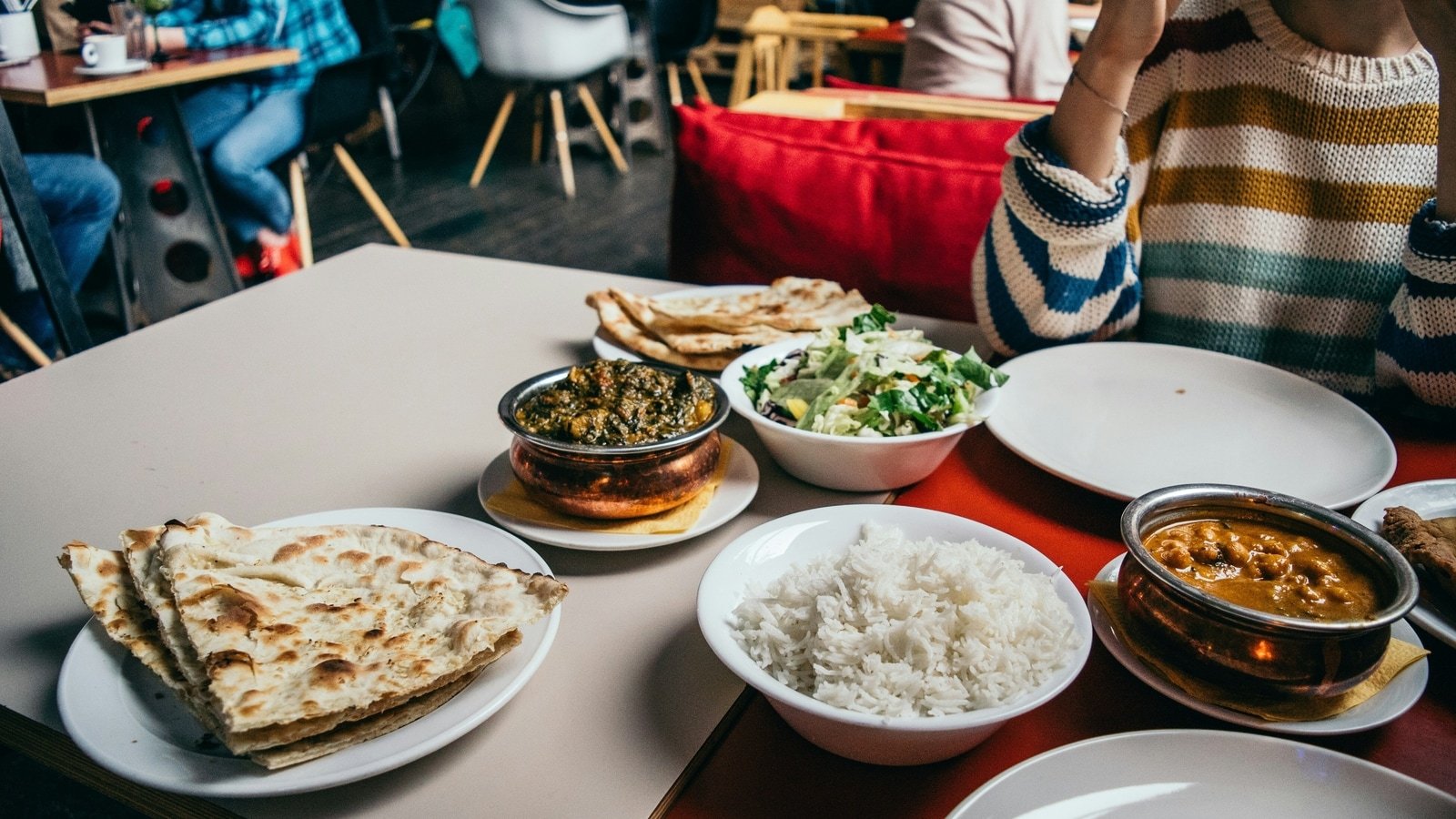
You have probably heard of Semma, the only Indian restaurant in New York to win a Michelin star. And of Gymkhana, the only Indian restaurant with two Michelin stars in London. Of Jamavar, the only Indian restaurant in the world to have won Michelin stars in three different avatars in three different cities: London, Doha and Dubai.
What, you may well ask, do these restaurants have in common?
There are two answers to this question. The first is the obvious one: they are all Indian restaurants run by chefs who have worked or trained in India. Vijaya Kumar of Semma is very proud of cooking the authentic cuisine of Tamil Nadu’s not-so-elevated castes and makes it hot and spicy. (He started out at the Taj Connemara in Chennai.) His boss, and one of the founders of Unapologetic Foods, which owns Semma, Chef Chintan Pandya, says that the group gets its name from its determination to refuse to apologise for the flavours and oil that characterise Indian food. (Chintan is ex-Oberoi.)
In London, one of the first things that Karam Sethi, the chef-founder of Gymkhana, said to me when I called to congratulate him on Gymkhana’s two stars was “it’s real Indian food, not ‘modern’ Indian.” Gymkhana serves the sort of food Indians actually eat, not a poncy, spice-deprived version. Gymkhana’s Executive Chef Sid Ahuja is ex-Oberoi and Sethi himself trained with ITC.
The most recognisable Indian of the top global restaurants is Jamavar. It was founded by Dinesh Nair, whose family used to own Leela Hotels, and is run by his whiz-kid daughter, Samyukta. The London Jamavar is international in clientele but you will nearly always see a top Indian movie star or cricketer there. This may have something to do with the fact that its chef, Surender Mohan, commands after his years working with the Leela group in India.
Samyukta and Surender took Jamavar to Doha where it became just one of two restaurants to win a Michelin star. (The other restaurant with a star is run by Alain Ducasse.) Next, they opened in Dubai and within a few months of opening, they had a star there too.
I met Surender at the Michelin ceremony in Dubai and was pleased to see that he was one of the few chefs not to be intimidated by the occasion and he gave the longest and best speech of the evening. But then I guess he is now used to attending these events in city after city.
Clearly something new and unusual is happening with Indian food abroad even if we don’t fully understand it here in India. There have been, broadly, four phases with Indian food in the West. The first was the ‘ethnic food’ phase when Indian food became the browner equivalent of chop suey and restaurants served mostly made-up Indian dishes at inexpensive prices.
The second was when Indian food went upmarket but was also Frenchified and plated. In the UK, restaurants serving this kind of food were celebrated and some got Michelin stars. In New York, Floyd Cardoz served two kinds of cuisine. At Tabla, he served a nouvelle take on Indian food and got three stars from the New York Times. But downstairs, at the Bread Bar, the food was more basic and less nouvelle. Even so, the general rule was that if you wanted rave reviews and high-profile rich guests, then you moved away from traditional Indian.
The third phase coincided with a global change in food preferences when French food ceased to be as admired as much. As El Bulli and later, Noma, set the trend, this was reflected in Indian food too. Gaggan Anand worked with the Adria brothers of El Bulli and opened a restaurant in Bangkok that served the kind of Indian food nobody had imagined could exist. Also, in Bangkok, Garima Arora opened Gaa which went on to win two Michelin stars. There was a fair amount of cross-fertilisation. Garima had worked with Rene Redzepi at Noma and with Gaggan. Redzepi himself had worked at El Bulli.
Almost simultaneously, Manish Mehrotra, whose resume included no great restaurants, invented his own version of modern Indian cuisine at Delhi’s Indian Accent. Mehrotra’s background was oriental cuisine so he had no interest in Frenchifying his food. Mehrotra and Gaggan ended up being the most influential Indian chefs of this century with their dishes being copied all over the world.
Himanshu Saini, the only Indian chef with a restaurant that has three Michelin stars (Dubai’s Tresind Studio) worked with Manish and is candid about his debt to the master.
But now I think we are into a third phase. People want Indian food without the frills. They want to eat like Indians eat in India. Vikas Khanna, India’s most famous chef, opened Bungalow in New York, serving food that was no different to the food he would serve in India and got three stars from the New York Times, and there’s usually a queue for tables outside his restaurant. At the less expensive end of the market Dhishoom which claims to be inspired by Mumbai’s Irani restaurants is so successful across the UK that it has now set its sights on America.
Of course, no change is absolute. There are still Bangladeshi curry houses calling themselves Indian restaurants. The Frenchified expensive Indian restaurants survive. The Gaggan-style modern Indian is still a rage.
But the trend is clear: Keep it simple and keep it spicy.
Restaurants & Food
Food Picks: Modern Indian with a Western twist at Firangi Superstar
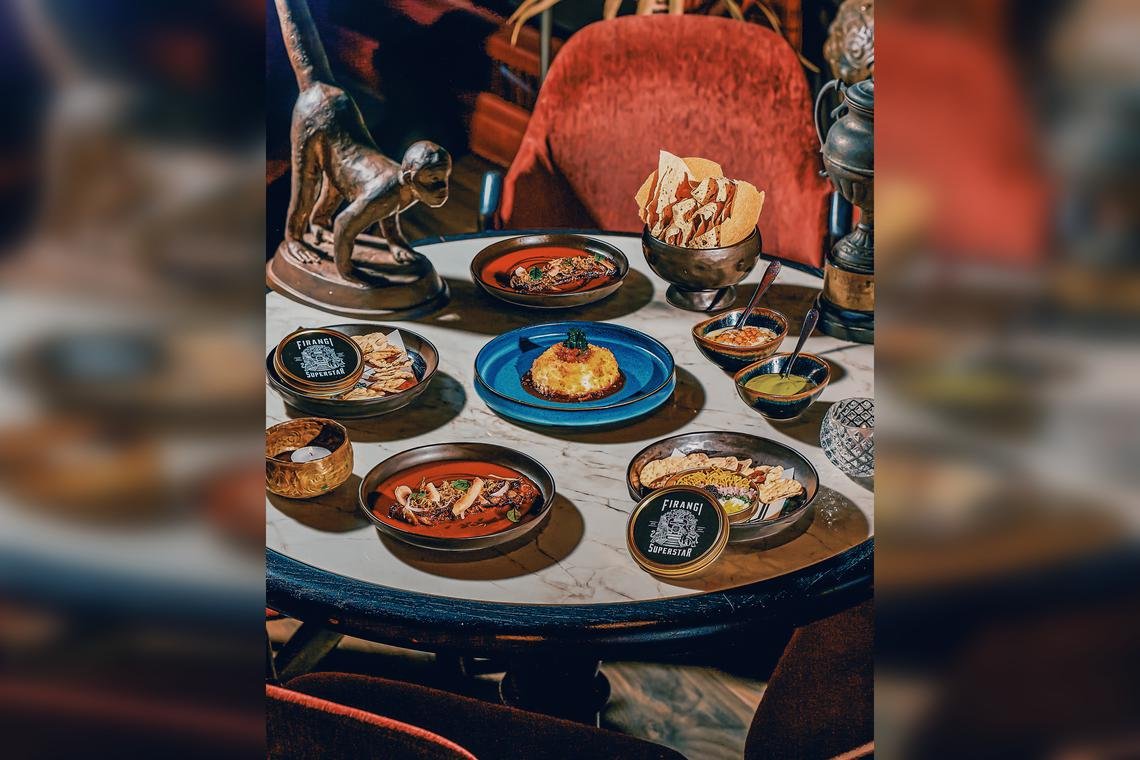
SINGAPORE – Do not be fooled by Firangi Superstar’s plain terracotta exterior. There is nothing minimalist about the experience here.
It overwhelms before the first bite even hits the table, spinning you through rooms crammed with memorabilia. Think American film-maker Wes Anderson on a trip through Delhi, a kind of kitschy fantasyland for colonial nostalgists wrapped in ornate wallpaper and studded with vintage firearms.
Thankfully, this meeting of worlds is far more amicable when confined to the kitchen of this modern Indian restaurant, which opened in 2021.
Firangi Superstar’s decor is as bold as its menu.
PHOTO: FIRANGI SUPERSTAR
Have a seat. Red? Blue? Cushion? Chair? Oh, here comes the menu, recently revamped and folded into a newspaper – with actual clippings, by the way, just in case you were done gawking at the mounted moose heads on the wall and wanted something else to look at.
Open it up. Today’s big story is a list of dishes, both old and new, Indian and international, all with characteristically eyebrow-waggling names.
Some riff off old iterations – This Is Also Not Aloo Gobi ($18++) still holds the traditional curry at arm’s length, even as it borrows its taste. Others squeeze in a winky pun – We’re Goan-Ing To Porto! ($96) beckons to diners with grilled Iberico pork and sorpotel chilli sauce.
Big personalities work only if backed up with big flavours, and Firangi Superstar’s bite is as good as its bark. Starters like Papi’s Jammed Gun ($29++), wagyu beef tartare with caviar, grated egg and gunpowder spice, and Big Baller Peperoner ($28++), its version of paneer Manchurian, with fried burrata and Manchurian chilli sauce, expertly fuse Western ideas with south Asian flair.
The Bengal Bake-Off from Firangi Superstar.
PHOTO: FIRANGI SUPERSTAR
Off to a riotous start, I move on to mains. The Bengal Bake-Off ($108++) is trotted out in show-stopping fashion: a salt-baked seabass emerges from its crust, tender and steaming, and is robed in Kasundi cream.
Back In The Saddle ($21++ for 100g) triumphantly rides in on tandoori-spiced lamb, crowned with confit garlic and chilli leaf. All these dishes also come in vegetarian form, should you so desire.
In the middle of this lip-smacking extravagance, a few humble sides quietly sneak their way onto the table. Turn your attention immediately to the black garlic naan ($14++). Look how pillowy the bread is, breathe in its nutty fragrance. You already know it is going to be a knockout.
End the night with some banoffee fritters ($14++) or Rasmalai “tres leches” ($16++). Recline back on your throne of pillows, cocktail or royal melon lassi ($20++) in hand.
Firangi – Hindi slang for foreigner – or no, one really does feel like a superstar here.
Where: 01-03, 20 Craig Road
MRT: Maxwell/Tanjong Pagar
Open: Noon to 2.30pm, 5.30 to 10pm (Mondays to Saturdays)
Info:
www.firangisuperstar.com
-

 Brand Stories3 weeks ago
Brand Stories3 weeks agoBloom Hotels: A Modern Vision of Hospitality Redefining Travel
-

 Brand Stories2 weeks ago
Brand Stories2 weeks agoCheQin.ai sets a new standard for hotel booking with its AI capabilities: empowering travellers to bargain, choose the best, and book with clarity.
-

 Destinations & Things To Do3 weeks ago
Destinations & Things To Do3 weeks agoUntouched Destinations: Stunning Hidden Gems You Must Visit
-

 Destinations & Things To Do2 weeks ago
Destinations & Things To Do2 weeks agoThis Hidden Beach in India Glows at Night-But Only in One Secret Season
-

 AI in Travel3 weeks ago
AI in Travel3 weeks agoAI Travel Revolution: Must-Have Guide to the Best Experience
-

 Brand Stories1 month ago
Brand Stories1 month agoVoice AI Startup ElevenLabs Plans to Add Hubs Around the World
-

 Brand Stories4 weeks ago
Brand Stories4 weeks agoHow Elon Musk’s rogue Grok chatbot became a cautionary AI tale
-

 Brand Stories2 weeks ago
Brand Stories2 weeks agoContactless Hospitality: Why Remote Management Technology Is Key to Seamless Guest Experiences
-

 Asia Travel Pulse1 month ago
Asia Travel Pulse1 month agoLooking For Adventure In Asia? Here Are 7 Epic Destinations You Need To Experience At Least Once – Zee News
-

 AI in Travel1 month ago
AI in Travel1 month ago‘Will AI take my job?’ A trip to a Beijing fortune-telling bar to see what lies ahead | China



